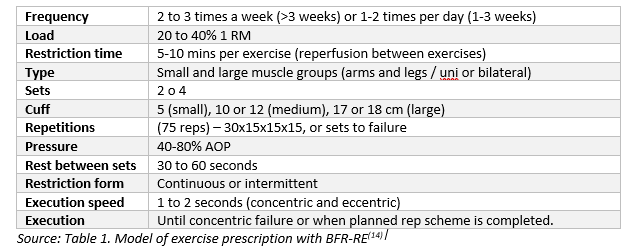
What is blood flow restriction training ?
The last years blood flow restriction training (BFR-training) is becoming more and more popular. Not only for the rehabilitation of sporters, but also in rehabilitation of the older generation. But what is blood flow restriction training now exactly and what do we know about it?
Blood flow restriction training (BFR-training) is an intervention, as mentioned in the name, where the blood flow gets limited by applying a cuff/tourniquet. The limitation in blood flow enables the possibility to train with a lower load while causing the same effects as you would with a higher load without the use of the BFR.
In this article we will discuss everything we know about blood flow restriction training, starting with how it all works to what the known risks are. After reading this article, you will definitely know it all!
How does blood flow restriction training work?
Blood flow restriction training seems to work due to the use of 3 primary mechanisms. Firstly, the increase of cellular swelling, secondly, enhancing metabolic stress, and thirdly, the increase of muscle fiber recruitment.
Now knowing what blood flow restriction is, lets take a look at how it works. Even though we are using low intensity training with BFR-training, research shows the same effects takes place as with high intensity resistance training.(1,2)
The simplest explanation of this effect is as following, due to the three primary mechanisms:(3,4)
Increased cellular swelling:
Research showed that increased cellular swelling can be a result of blood pooling, accumulation of metabolites (which is the left-over products after metabolism), and reactive hyperemia (which is the increase of blood flow because of occlusion of the artery), after removal of the cuff.(3,4)
Enhanced metabolic stress
We won’t go too much in detail about this, but by increasing the metabolic stress you can improve hypertrophy (an increase and growth of muscle cells).
The article that we read, showed that the increase in metabolic stress resulted to hypertrophy even though they used short training periods and low-intensity resistance training, in combination with BFR-training.(5)
Increased muscle fiber recruitment
The increase of metabolites, as we mentioned before, can be a result to cellular swelling, but it can also increase muscle fiber recruitment of group III (thinly myelinated) and group IV (unmyelinated) afferents.(6)
“It is postulated that this may increase fast-twitch fiber recruitment by inhibiting the alpha motor neuron, which ultimately supplies slow-twitch fibers”(3,6)
Differences between blood flow restriction training and normal strength training
Here, we will discuss the differences found between BFR-training and low-load resistance training, as well as the differences between BFR-training and high-load resistance training.
BFR-training vs. low-load resistance training
Since we know BFR-training can improve hypertrophy and strength gains let’s see what research says about the difference between BFR-training in combination with low-load resistance training and just low-load resistance training.
Research showed a greater increase in muscle size and strength when exercising in combination with BFR, compared with low-load resistance training alone.(7)
They also stated that: “Training intensity typically required to maximize increases in strength and hypertrophy ranges from 45%-60% 1RM in untrained individuals, or 80%-85% 1RM in trained athletes, the accumulated evidence showing alterations in strength and hypertrophy with low loads (20%-50% 7 1RM), is convincing verification that BFR contributes substantially to these adaptive processes.”(7)
BFR-training vs high-load resistance training
Low-load resistance training seems to get beaten by the combination of BFR and low-load resistance training, but what is the difference between BFR-training and high-load resistance training?
Researchers showed that BFR-training in combination with low-load resistance training was more effective and also a more tolerable approach to heavy-load resistance training in rehabilitation.(8)
However, other research showed that BFR in combination with low load resistance training was equally effective in increasing muscle mass. However, they found out that that BFR seemed to be inferior in electing muscle strength responses in comparison with high-load resistance training.(9)
Is blood flow restriction training safe?

*Disclaimer don’t start anything without consultancy of professionals!
At this point you know a lot about BFR-training, but the main questions remains: Is BFR-training safe? In this chapter we will look at the contraindications and any known side-effects of BFR-training.
The contraindications for BFR training
We found two studies that stated that patients are possibly at risk of adverse reactions, who: (10,11)
- Those with poor circulatory systems,
- Obesity
- Diabetes
- Arterial calcification
- Sickle cell trait
- Severe hypertension
- Or renal compromise
Other potential contraindications to consider, are:(10,11)
- Venous thromboembolism (Blood clots in the veins)
- Peripheral vascular compromise (slow progressive circulation disorder)
- Sickle cell anemia (not enough healthy red blood cells to carry oxygen)
- Extremity infection
- Lymphadenectomy (surgery to remove lymph nodes)
- Cancer or tumor
- Medications known to increase clotting risk.
It is also stated that every patient needs to be prescreened before application of BFR!(10,11)
Safety of blood flow restriction training
At the moment, there is a lot of research regarding the safety of BFR-training. Multiple research, noted a few safety aspects that need to be considered before trying BFR such as; thrombus formation, muscle damage, abnormal exercise pressure reflex, and nerve conduction. Do know, that the incidences for these risks are relatively low.(12)
We decided to put these safety measures in a different blog. We do, however, want to mention one quote from one of the studies:
“More research should be completed to better determine under what conditions this type of training can be safely used” However they also stated that: “The current research on BFR-training with respect to safety outcomes confirms earlier reports that BFR-training, when used in a controlled environment by trained and experienced personnel, provides a safe training alternative for most individuals regardless of age and training status.”(13)
Exercise prescription for BFR-training in combination with resistance training (BFR-RE)
In this blog we mainly discussed the BFR-training in combination with resistance training. That is why we will only discuss the exercise prescription with BFR and resistance training.(14)
| Frequency | 2 to 3 times a week (>3 weeks) or 1-2 times per day (1-3 weeks) |
| Load | 20 to 40% 1 RM |
| Restriction time | 5-10 mins per exercise (reperfusion between exercises) |
| Type | Small and large muscle groups (arms and legs / uni or bilateral) |
| Sets | 2 o 4 |
| Cuff | 5 (small), 10 or 12 (medium), 17 or 18 cm (large) |
| Repetitions | (75 reps) – 30x15x15x15, or sets to failure |
| Pressure | 40-80% AOP |
| Rest between sets | 30 to 60 seconds |
| Restriction form | Continuous or intermittent |
| Execution speed | 1 to 2 seconds (concentric and eccentric) |
| Execution | Until concentric failure or when planned rep scheme is completed. |
Source: Table 1. Model of exercise prescription with BFR-RE(14)
Our vision on blood flow restriction training

BFR training seems like a good option for people who can’t perform high-load resistance training. However, more research is needed about the safety of BFR-training in every patient category. We also want to mention that it is important to prescreen yourself or your patient before trying out BFR. It’s important to know the pros and cons of BFR-training and we hope you have a better view on what BFR-training is after reading this blog!
Frequently asked questions
“More research should be completed to better determine under what conditions this type of training can be safely used” However they also stated that: “The current research on BFR-training with respect to safety outcomes confirms earlier reports that BFR-training, when used in a controlled environment by trained and experienced personnel, provides a safe training alternative for most individuals regardless of age and training status.”(13)

We found two study’s that stated that patients are possibly at risk of adverse reactions, who: (10,11)
– Those with poor circulatory systems,
– Obesity
– Diabetes
– Arterial calcification
– Sickle cell trait
– Severe hypertension
– Or renal compromise
Other potential contraindications to consider, are:(10,11)
– Venous thromboembolism (Blood clots in the veins)
– Peripheral vascular compromise (slow progressive circulation disorder)
– Sickle cell anemia (not enough healthy red blood cells to carry oxygen)
– Extremity infection
– Lymphadenectomy (surgery to remove lymph nodes)
– Cancer or tumor
– Medications known to increase clotting risk.
It is also stated that every patient needs to be prescreened before application of BFR!(10,11)
Blood flow restriction training seems to work due to the use of 3 primary mechanisms. Firstly, the increase of cellular swelling, secondly, enhancing metabolic stress, and thirdly, the increase of muscle fiber recruitment.
Sources
- Vechin FC, Libardi CA, Concei0a˜o MS, et al. Comparisons between low-intensity resistance training with blood flow restriction and high-intensity resistance training on quadriceps muscle mass and strength in elderly. J Strength Cond Res. 2015;29(4):1071–6
- Lixandrao ME, Ugrinowitsch C, Berton R, et al. Magnitude of muscle strength and mass adaptations between high-load resistance training versus low-load resistance training associated with blood-flow restriction: a systematic review and meta-analysis. Sports Med. 2017; [Epub ahead of print]. doi:10.1007/s40279-017-0795-y
- Wilson JM, Lowery RP, Joy JM, Loenneke JP, Naimo MA. Practical blood flow restriction training increases acute determinants of hypertrophy without increasing indices of muscle damage. J Strength Cond Res. 2013 Nov;27(11):3068-75. doi: 10.1519/JSC.0b013e31828a1ffa. PMID: 23446173.
- Loenneke, JP, Fahs, CA, Rossow, LM, Abe, T, and Bemben, MG. The anabolic benefits of venous blood flow restriction training may be induced by muscle cell swelling. Med Hypotheses 78: 151– 154, 2012.
- Takada S, Okita K, Suga T, Omokawa M, Kadoguchi T, Sato T, Takahashi M, Yokota T, Hirabayashi K, Morita N, Horiuchi M, Kinugawa S, Tsutsui H. Low-intensity exercise can increase muscle mass and strength proportionally to enhanced metabolic stress under ischemic conditions. J Appl Physiol (1985). 2012 Jul;113(2):199-205. doi: 10.1152/japplphysiol.00149.2012. Epub 2012 May 24. PMID: 22628373.
- Yasuda, T, Abe, T, Brechue, WF, Iida, H, Takano, H, Meguro, K, Kurano, M, Fujita, S, and Nakajima, T. Venous blood gas and metabolite response to low-intensity muscle contractions with external limb compression. Metabolism 59: 1510–1519, 2010.
- Slysz J, Stultz J, Burr JF. The efficacy of blood flow restricted exercise: A systematic review & meta-analysis. J Sci Med Sport. 2016 Aug;19(8):669-75. doi: 10.1016/j.jsams.2015.09.005. Epub 2015 Sep 28. PMID: 26463594.
- Hughes L, Paton B, Rosenblatt B, Gissane C, Patterson SD. Blood flow restriction training in clinical musculoskeletal rehabilitation: a systematic review and meta-analysis. Br J Sports Med. 2017 Jul;51(13):1003-1011. doi: 10.1136/bjsports-2016-097071. Epub 2017 Mar 4. PMID: 28259850.
- Centner C, Wiegel P, Gollhofer A, König D. Effects of Blood Flow Restriction Training on Muscular Strength and Hypertrophy in Older Individuals: A Systematic Review and Meta-Analysis. Sports Med. 2019 Jan;49(1):95-108. doi: 10.1007/s40279-018-0994-1. Erratum in: Sports Med. 2018 Nov 9;: PMID: 30306467; PMCID: PMC6349784.
- DePhillipo, N. N., Kennedy, M. I., Aman, Z. S., Bernhardson, A. S., O’Brien, L., & LaPrade, R. F. (2018). Blood Flow Restriction Therapy After Knee Surgery: Indications, Safety Considerations, and Postoperative Protocol. Arthroscopy techniques, 7(10), e1037–e1043. https://doi.org/10.1016/j.eats.2018.06.010
- Association of Operating Room Nurses . Preoperative standards and recommended practices for inpatient and ambulatory settings. AORN Inc; Denver, CO: 2014. Recommended practices for use of the pneumatic tourniquet in the preoperative practice setting; pp. 183–208. [Google Scholar] [Ref list]
- Vanwye WR, Weatherholt AM, Mikesky AE. Blood Flow Restriction Training: Implementation into Clinical Practice. Int J Exerc Sci. 2017 Sep 1;10(5):649-654. PMID: 28966705; PMCID: PMC5609669.
- Loenneke JP, Wilson JM, Wilson GJ, Pujol TJ, Bemben MG. Potential safety issues with blood flow restriction training. Scand J Med Sci Sports. 2011 Aug;21(4):510-8. doi: 10.1111/j.1600-0838.2010.01290.x. Epub 2011 Mar 16. PMID: 21410544.
- Patterson SD, Hughes L, Warmington S, Burr J, Scott BR, Owens J, Abe T, Nielsen JL, Libardi CA, Laurentino G, Neto GR, Brandner C, Martin-Hernandez J, Loenneke J. Blood Flow Restriction Exercise: Considerations of Methodology, Application, and Safety. Front Physiol. 2019 May 15;10:533. doi: 10.3389/fphys.2019.00533. Erratum in: Front Physiol. 2019 Oct 22;10:1332. PMID: 31156448; PMCID: PMC6530612.

